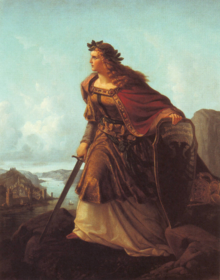Lorenz Clasen

Lorenz Clasen (born December 14, 1812 in Düsseldorf , † May 31, 1899 in Leipzig ) was a German history and portrait painter of the Düsseldorf School , art critic and publicist .
Life

After starting a law degree at the University of Bonn at the request of his father , he switched to the Düsseldorf Art Academy in 1829 . There he was a student of Heinrich Christoph Kolbe , Theodor Hildebrandt and Wilhelm Schadow , from 1840 to 1849 in the latter's master class . In addition to painting, he worked as an art critic and delivered much-read art reports early on for Düsseldorf and foreign journals. In 1842 he went to the court of Neuwied as a teacher to Prince Maximilian zu Wied-Neuwied and the Princess . In the next few years he executed part of the frescoes in the hall of the Elberfeld town hall and painted historical scenes.
From the second half of 1845 to 1846 he worked as an art critic for the "Düsseldorfer Zeitung". From 1847 to the end of 1849 he was editor-in-chief of the Düsseldorfer Monatshefte , then moved to Berlin and, in the early 1850s, permanently to Leipzig. There he worked on the conversation lexicon for fine arts with Johann Andreas Romberg and other authors . He also directed the Payne's family journal, among other things .
During the March Revolution , Clasen was deputy commander of the revolutionary Düsseldorf vigilante . When her boss, Clasen's cousin Lorenz Cantador , resigned on August 19, 1848, Clasen was entrusted with command. Another cousin of Clasen was the late Nazarene Carl Clasen .
Works
painting
Clasen's best-known work is Germania auf der Wacht am Rhein (in Krefeld Town Hall ), which in the 1870s was as popular as the folk song “ Die Wacht am Rhein ” and was copied many times .
- Early works:
- The first Christians
- The shepherds at the birth of the Savior
- Scenes from the life of the Heil. Elisabeth
- Further works (selection):
- The conversion of Clovis by his wife Clotilde (1839)
- The blessings of peace and industry and
- Entry of a happy ruling couple (1844, frescoes in Elberfeld town hall )
- The bishops of Cologne and Mainz urge his wife Gisela to divorce his wife Gisela at the coronation of Konrad II (1847)
- Luther burns the bull of excommunication (1848)
- Otto von Wittelsbach
- The Singers' War at the Wartburg
- Konrad II in the Römersaal in Frankfurt a. M.
- The Wuppertal industry under the protection of the Hohenzollern royal family (cycle, for Friedrich Wilhelm IV.)
- The murder of Adalbert von Cleve (for Prince Wilhelm)
- The magician Merlin (after Immermann)
- Germania auf der Wacht am Rhein (1860), given in 1864 by Eduard Prell-Erckens to the "father town of Crefeld" (in Krefeld initially in the town hall, later exhibited in the Kaiser Wilhelm Museum )
- Germania on the Sea (1865)
Fonts
- Camp scenes, collected on the Salzkotten maneuver ”, a“ humorous attempt , 1836
- The art lover's travel adventure , Hoffmann & Campe 1847
- The entry of the devil into Leipzig, from an inspired man - a booklet for the clever and dumb , satirical and humorous
- Experienced and interwoven; from a painter's writing case. Novellas
Illustrations (selection)
- In: German seals with marginal drawings by German artists. - Düsseldorf: Buddeus, (volumes 1–2) 1843. Digitized edition of the University and State Library Düsseldorf
literature
- Clasen, Lorenz . In: Ulrich Thieme (Hrsg.): General Lexicon of Fine Artists from Antiquity to the Present . Founded by Ulrich Thieme and Felix Becker . tape 7 : Cioffi – Cousyns . EA Seemann, Leipzig 1912, p. 56 ( Textarchiv - Internet Archive ).
- Eduard Daelen : Clasen, Lorenz . In: Allgemeine Deutsche Biographie (ADB). Volume 47, Duncker & Humblot, Leipzig 1903, p. 496 f.
Web links
Individual evidence
- ↑ See nos. 2061–2081 in the finding aid 212.01.04 Student lists of the Düsseldorf Art Academy , website in the archive.nrw.de portal ( North Rhine-Westphalia State Archive )
- ^ Wolfgang Hütt : Die Düsseldorfer Malerschule 1819–1869 . VEB EA Seemann Buch- und Kunstverlag, Leipzig 1984, p. 61 f.
| personal data | |
|---|---|
| SURNAME | Clasen, Lorenz |
| BRIEF DESCRIPTION | German history painter and publicist |
| DATE OF BIRTH | December 14, 1812 |
| PLACE OF BIRTH | Dusseldorf |
| DATE OF DEATH | May 31, 1899 |
| Place of death | Leipzig |
